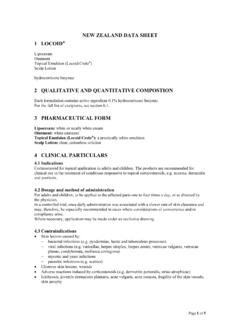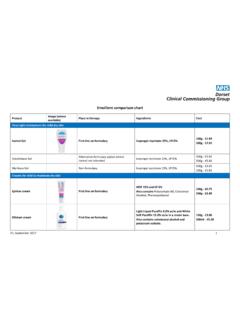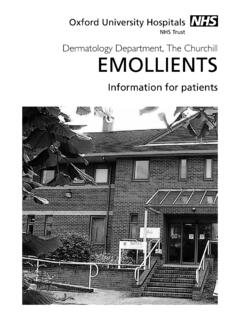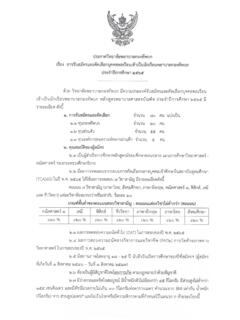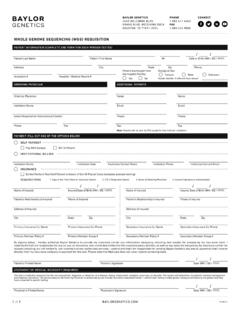Transcription of How to Use EASI
1 EASI guidance December 14 how to use easi The EASI scoring system uses a defined process to grade the severity of the signs of eczema and the extent affected: 1. Select a body region Four body regions are considered separately: 2. Assess the extent of eczema in that body region Each body region has potentially 100% involvement. Using the table below, give each respective body region a score of between 0 and 6 based on the percentage involvement. Precise measurements are not required. % involvement 0 1-9% 10 - 29% 30 - 49% 50 - 69% 70 - 89% 90 - 100% Region score 0 1 2 3 4 5 6 To aid in your body region grading you can use the diagrams in Appendix 1. 3. Assess the severity of each of the four signs in that body region: Grade the severity of each sign on a scale of 0 to 3: 0 None 1 Mild 2 Moderate 3 Severe To aid your severity grading, a photographic atlas of suggested categories is available in Appendix 2 . Remember: Include only inflamed areas in your assessment; do not include xerosis (dryness), ichthyosis , keratosis pilaris, urticaria, infection (unless there is underlying eczema), or post inflammatory pigmentation changes.
2 Head and neck Trunk (including the genital area) Upper extremities Lower Extremities (including the buttocks) Take an average of the severity across the involved region. Half points ( and ) may be used. is not permitted if a sign is present it should be at least mild (1) Palpation may be useful in assessing edema/papulation as well as lichenification 1. Erythema 2. Edema/papulation 3. Excoriation 4. Lichenification Further explanations of these terms can be found in FAQ s (Appendix 4) EASI guidance December 14 How to record your scores The assessed parameters are inserted into a table (example shown below for age 8 years). The final EASI score ranges from 0-72. Body region Erythema Edema/ papulation Excoriation Lichenification Area score Multiplier Score Head/neck ( + + + ) X X Trunk ( + + + ) X X Upper extremities ( + + + ) X X Lower extremities ( + + + ) X X The final EASI score is the sum of the 4 region scores _____ (0-72) Two forms of the EASI scoring system are available depending on the age of the patients.
3 The multipliers for the region score are different in the under 8 s version to reflect the relative proportion of body regions in young children: Patients 8 years or above Patients under 8 years of age. The forms can be found in appendix and and also as word documents on the HOME website ( ) Total EASI = Sum of products Multiply by area score Multiply by preset factor Assessed in 4 body regions separately EASI guidance December 14 Appendix 1: Eczema Area and Severity Index (EASI) - Extent of eczema per body region Score each region from 0 to 100% Head & neck Upper extremities Trunk Lower extremities EASI guidance December 14 Appendix 2: Eczema Area and Severity Index (EASI) lesion severity atlas EASI guidance December 14 Appendix : Eczema Area and Severity Index (EASI) case report form age <8 years Area of Involvement: Each body region has potentially 100% involvement. Score 0 to 6 based on the following table: % involvement 0 1-9% 10 - 29% 30 - 49% 50 - 69% 70 - 89% 90 - 100% Region score 0 1 2 3 4 5 6 Severity of Signs: Grade the severity of each sign on a scale of 0 to 3: 0 None 1 Mild 2 Moderate 3 Severe Scoring table: Body region Erythema (0-3) Edema/ Papulation (0-3) Excoriation (0-3) Lichenification(0-3) Region score (0-6) Multiplier Score per body region Head/neck ( + + + ) X X Trunk ( + + + ) X X Upper extremities ( + + + ) X X Lower extremities ( + + + ) X X The final EASI score is the sum of the 4 region scores: _____ (0-72) Take an average of the severity across the involved area.
4 Half points may be used EASI guidance December 14 Appendix : Eczema Area and Severity Index (EASI) case report form - age 8 years Area of Involvement: Each body area has potentially 100% involvement. Score 0 to 6 based on the following table: % involvement 0 1-9% 10 - 29% 30 - 49% 50 - 69% 70 - 89% 90 - 100% Region score 0 1 2 3 4 5 6 Severity of Signs: Grade the severity of each sign on a scale of 0 to 3: 0 None 1 Mild 2 Moderate 3 Severe Scoring table: Body region Erythema (0-3) Edema/ Papulation (0-3) Excoriation (0-3) Lichenification(0-3) Region score (0-6) Multiplier Score per body region Head/neck ( + + + ) X X Trunk ( + + + ) X X Upper extremities ( + + + ) X X Lower extremities ( + + + ) X X The final EASI score is the sum of the 4 region scores: _____ (0-72) Take an average of the severity across the involved area. Half points may be used EASI guidance December 14 Appendix 4 - Frequently Asked Questions What is the difference between edema/papulation and lichenification?
5 Consider edema/papulation as corresponding to the acute signs of atopic dermatitis that reflect histological spongiosis. Lichenification are more firm thickened plaques with accentuation of the skin markings that develop as a result of prolonged scratching or rubbing in chronic disease. In darker skin types, follicular lichenification may present as firm flat-topped discrete papules. Grade these chronic lesions as lichenification. How do I grade prurigo nodules? Prurigo nodules are larger, deeper lesions as a result of chronic scratching and are graded as areas of lichenification. How do I grade erythema in darker skin? To avoid underestimating inflammation in patients with darker skin tones, take into account the underlying skin pigment when grading erythema. Often this means increasing your erythema grade by one level. Can half-steps be used to assess lesion severity? The original EASI validation study allowed for half steps. These may be helpful when trying to average the severity of a parameter over a region.
6 For example, if there are some areas with an erythema grading of 2 and some areas more consistent with a severity of 3, may be a good choice. What if most areas in a region are a severity grade of 1, but there are some areas that are a grade 3? Attempt to average the severity across the involved areas in that region. If these areas are close to equal in size, a score of 2 would be most appropriate. If the majority of involved areas are a grade 1, a score of 1 or is more appropriate. Be careful not to score the highest severity in a region but the average one. How do I grade xerosis (dryness), ichthyosis and hyperlinear palms? Unless there is active acute or chronic eczema overlying these findings, they are not included in the EASI assessment. How precise should my assessment of eczema extent be? The region scores, which reflect the extent of eczema, were designed and validated as rough estimates of the percentage of involved skin. Each region is given a score ranging from 0 to 6, based on a ballpark estimation of extent (see region score table in page 1).
7 If you find it difficult to provide a rough estimate of disease extent, you can use the schematics in Appendix 1 to guide you. More time-consuming methods for evaluating disease extent such as the rule of nines or the palm method are generally unnecessary, as the EASI was designed to EASI guidance December 14 My patient has responded well to treatment and significantly improved since the last visit. Should I adjust the grading based on the patient s relative improvement? No. The EASI is a static score, meaning that it is done independently at each time point to reflect current severity. You should grade the EASI per visit regardless of the previous status. Studies have shown that the EASI score has good responsiveness, meaning that overall it is sensitive to change and the improvement will be reflected in the total score. Can the EASI be used in children? Yes. The EASI is performed in the same method in all age groups, but the calculation of the final EASI score differs by age.
8 When calculating the EASI, each of the 4 region scores is multiplied by a constant which reflects the relative contribution of that region to the total body surface area. For patients 8 years and older the multipliers are for the head/neck, for the upper extremities, for the trunk and for the lower extremities. Below 8 years of age the head/neck multiplier is increased to while the lower extremities multiplier decreases to , consistent with the proportions of these regions in childhood. Refer to Appendix 3 for EASI forms by age. What happens if a child turns 8 during the course of the study? Which EASI formula should I use? There are no clear-cut definitions for this situation. In general, if the study is a short term study such as an RCT lasting a few months using the same formula throughout the trial is preferred, even if the child turns 8 during these months. Keeping the EASI formula consistent in this scenario can serve to preserve the EASI sensitivity to change ( its change in response to treatment) without compromising the validity of the score.
9 In long term studies such as cohort studies lasting a year or longer, it is important to update the EASI formula based on the physical changes children go through. Switching to the age 8+ formula once a child is older is preferred in that scenario. What do the terms erythema, edema/papulation, excoriation and lichenification mean? These are key signs of atopic dermatitis. Recognizing and grading them properly requires training on the visual and physical exam consistent with these signs. Generally speaking, erythema is skin redness; edema/papulation refers to an elevation or swelling of the skin (that should be differed from lichenification below); excoriations are scratch marks that have broken the skin surface; and lichenification is a leathery thickening of the skin with exaggerated skin markings.





